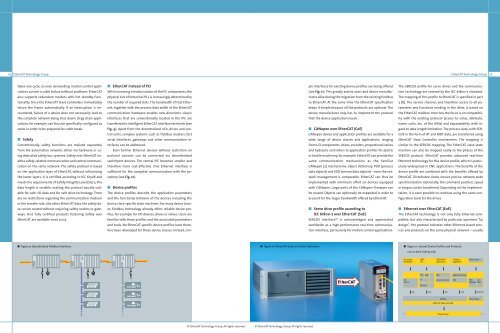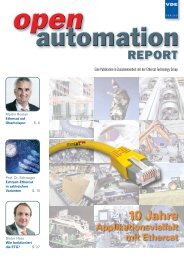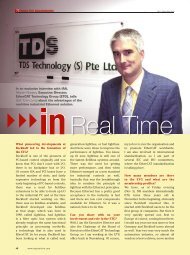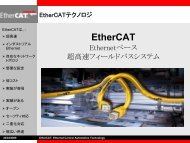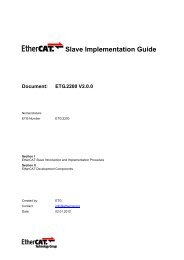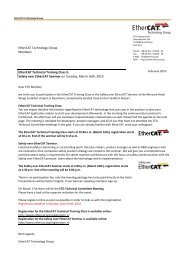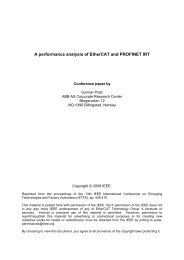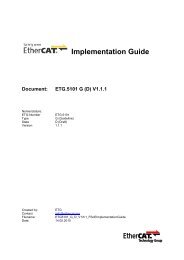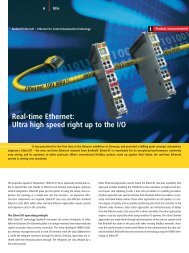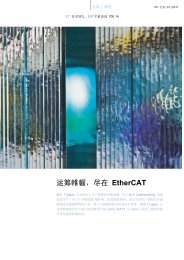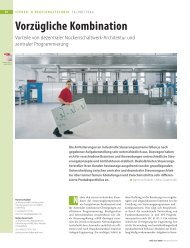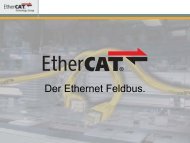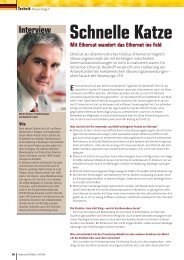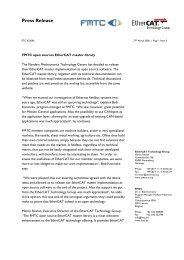EtherCAT for Embedded Systems
EtherCAT for Embedded Systems
EtherCAT for Embedded Systems
You also want an ePaper? Increase the reach of your titles
YUMPU automatically turns print PDFs into web optimized ePapers that Google loves.
■ Technical Introduction and Overview<br />
8 <strong>EtherCAT</strong> Technology Group 9<br />
<strong>EtherCAT</strong> Technology Group<br />
This section provides an in-depth introduction into <strong>EtherCAT</strong>, the Ethernet-based fieldbus system.<br />
<strong>EtherCAT</strong> sets new per<strong>for</strong>mance standards. Handling is straight<strong>for</strong>ward and similar to a fieldbus, thanks<br />
to flexible topology and simple configuration. Moreover, since <strong>EtherCAT</strong> can be implemented very<br />
cost-effectively, the system enables fieldbuses to be used in applications where fieldbus networking<br />
was not an option in the past.<br />
■ Introduction<br />
Fieldbuses have become an integrated component of automation<br />
technology. They have been tried and tested and<br />
are now widely established. It was fieldbus technology<br />
that enabled the wide-scale application of PC-based control<br />
systems. While the per<strong>for</strong>mance of controller CPUs –<br />
particularly <strong>for</strong> IPCs – is increasing rapidly, conventional<br />
fieldbus systems tend to represent “bottlenecks” that limit<br />
the per<strong>for</strong>mance control systems can achieve. An additional<br />
factor is the layered control architecture consisting<br />
of several subordinate (usually cyclic) systems: the actual<br />
control task, the fieldbus system and perhaps local expansion<br />
buses within the I/O system or simply the local<br />
firmware cycle in the peripheral device. Reaction times are<br />
typically 3–5 times higher than the controller cycle time –<br />
an unsatisfactory solution.<br />
Above the fieldbus system level, i.e. <strong>for</strong> networking<br />
controllers, Ethernet has already been the state of the art<br />
<strong>for</strong> some time. What is relatively new is its application at<br />
the drive or I/O level, i.e. in areas that were dominated by<br />
Input<br />
Conversion<br />
Input<br />
Communication<br />
I/O Response Time 100 µs<br />
Logic Calculation Output Output<br />
Commu- Conversion<br />
nication<br />
fieldbus systems in the past. The main requirements <strong>for</strong><br />
this type of application are high real-time capability, suitability<br />
<strong>for</strong> small data quantities, and naturally cost-effectiveness.<br />
<strong>EtherCAT</strong> meets these requirements and at the<br />
same time makes internet technologies available at the<br />
I/O level.<br />
With <strong>EtherCAT</strong> the controller can update the input<br />
and/or output in<strong>for</strong>mation at the time when the data is<br />
needed. The I/O response time contains all hardware relevant<br />
delays (IPC, <strong>EtherCAT</strong> and I/O system) from the physical<br />
input signal to the physical reaction on the output.<br />
With a time of ≤ 100 μs this offers a per<strong>for</strong>mance to<br />
the PLC level that has been available up to now only<br />
within servo drives with a digital signal processor (DSP),<br />
(see Fig. 1).<br />
■ Ethernet and real-time capability<br />
There are many different approaches that try and provide<br />
real-time capability <strong>for</strong> Ethernet: <strong>for</strong> example, the CS-<br />
MA/CD media access procedure is disabled via higher level<br />
■ Figure 1: Ultra short cylce times with I/O response time < 100 μs ■ Figure 2: Process data is inserted in datagram<br />
© <strong>EtherCAT</strong> Technology Group. All rights reserved. © <strong>EtherCAT</strong> Technology Group. All rights reserved.<br />
protocol layers and replaced by the time slice procedure or<br />
polling; other propositions use special switches that distribute<br />
Ethernet packets in a precisely controlled timely<br />
manner. Whilst these solutions may be able to transport<br />
data packets more or less quickly and accurately to the<br />
connected Ethernet nodes, the times required <strong>for</strong> the redirection<br />
to the outputs or drive controllers and <strong>for</strong> reading<br />
the input data strongly depend on the implementation.<br />
If individual Ethernet frames are used <strong>for</strong> each device,<br />
the usable data rate is very low in principle: The shortest<br />
Ethernet frame is 84 bytes long (incl. inter-packet gap IPG).<br />
If, <strong>for</strong> example, a drive cyclically sends 4 bytes of actual value<br />
and status in<strong>for</strong>mation and accordingly receives 4 bytes<br />
of command value and control word in<strong>for</strong>mation, at 100 %<br />
bus load (i.e. with infinitely short response time of the<br />
drive) a usable data rate of only 4/84 = 4.8 % is achieved. At<br />
an average response time of 10 μs, the rate drops to 1.9 %.<br />
These limitations apply to all real-time Ethernet approaches<br />
that send an Ethernet frame to each device (or expect a<br />
frame from each device), irrespective of the protocols used<br />
within the Ethernet frame.<br />
■ <strong>EtherCAT</strong> operating principle<br />
<strong>EtherCAT</strong> technology overcomes these inherent limitations<br />
of other Ethernet solutions: On the one hand the Ethernet<br />
packet is no longer received then interpreted and process<br />
data then copied at every device, but the <strong>EtherCAT</strong> slave<br />
devices read the data addressed to them while the frame<br />
Ethernet Header ECAT HDR Datagram 1 Datagram 2 Datagram 3 Ethernet<br />
Logical Process Image<br />
Task 1<br />
Logical Process Image<br />
Task 2<br />
Logical Process Image<br />
Task 3<br />
passes through the node. Similarly, input data is inserted<br />
while the telegram passes through (see Fig. 2). The frames<br />
are only delayed by a few nanoseconds. The frame send by<br />
the master is passed through to the next device until it<br />
reaches the end of the segment (or branch). The last device<br />
detects an open port and there<strong>for</strong>e sends the frame back<br />
to the master.<br />
On the other hand, an <strong>EtherCAT</strong> frame comprises the<br />
data of many devices both in send and receive direction<br />
within one Ethernet frame. The usable data rate increases<br />
to over 90 %. The full-duplex features of 100BaseTX are fully<br />
utilized, so that effective data rates of > 100 Mb/s (> 90 %<br />
of 2 x 100 Mb/s) can be achieved (see Fig. 3).<br />
The <strong>EtherCAT</strong> master uses standard Ethernet Medium<br />
Access Controllers (MACs) without extra communication<br />
processors. Thus an <strong>EtherCAT</strong> master can be implemented<br />
on any equipment controller that provides an Ethernet interface,<br />
independently of the operating system or application<br />
environment.<br />
The <strong>EtherCAT</strong> slave uses an <strong>EtherCAT</strong> Slave Controller<br />
(ESC) <strong>for</strong> processing the data on-the-fly. Thus the per<strong>for</strong>mance<br />
of the network is not determined by the microcontroller<br />
per<strong>for</strong>mance of the slave but is handled complete in<br />
hardware. A process data interface (PDI) to the slave‘s application<br />
offers a Dual-Port-RAM <strong>for</strong> data exchange.<br />
■ Figure 3: Comparison of Bandwidth Utilisation<br />
100<br />
90<br />
80<br />
70<br />
60<br />
50<br />
40<br />
30<br />
20<br />
10<br />
0<br />
2-5%<br />
Polling/<br />
Timeslicing<br />
20-30%<br />
Broadcast<br />
Master➝Slave<br />
At 4 Byte user data<br />
per note<br />
80-97%<br />
<strong>EtherCAT</strong><br />
From 2 Bit<br />
user data<br />
per note


